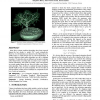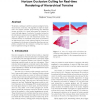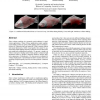VISUALIZATION
2002
IEEE
14 years 4 months ago
2002
IEEE
Many direct volume rendering algorithms have been proposed during the last decade to render 2563 voxels interactively. However a lot of limitations are inherent to all of them, li...
VISUALIZATION
2002
IEEE
14 years 4 months ago
2002
IEEE
Typically 3-D MR and CT scans have a relatively high resolution in the scanning X;Y plane, but much lower resolution in the axial Z direction. This non-uniform sampling of an obje...
VISUALIZATION
2002
IEEE
14 years 4 months ago
2002
IEEE
Critical points of a vector field are key to their characterization. Not only their positions but also their indexes are crucial for understanding vector fields. Considerable wo...
VISUALIZATION
2002
IEEE
14 years 4 months ago
2002
IEEE
Motion provides strong visual cues for the perception of shape and depth, as demonstrated by cognitive scientists and visual artists. This paper presents a novel visualization tec...
VISUALIZATION
2002
IEEE
14 years 4 months ago
2002
IEEE
VISUALIZATION
2002
IEEE
14 years 4 months ago
2002
IEEE
The Gauss map projects surface normals to a unit sphere, providing a powerful visualization of the geometry of a graphical object. It can be used to predict visual events caused b...
VISUALIZATION
2002
IEEE
14 years 4 months ago
2002
IEEE
We present a technique to perform occlusion culling for hierarchical terrains at run-time. The algorithm is simple to implement and requires minimal pre-processing and additional ...
VISUALIZATION
2002
IEEE
14 years 4 months ago
2002
IEEE
Direct volume rendering is a commonly used technique in visualization applications. Many of these applications require sophisticated shading models to capture subtle lighting effe...
VISUALIZATION
2002
IEEE
14 years 4 months ago
2002
IEEE
Most systems used for creating and displaying colormap-based visualizations are not photometrically calibrated. That is, the relationship between RGB input levels and perceived lu...
VISUALIZATION
2002
IEEE
14 years 4 months ago
2002
IEEE



